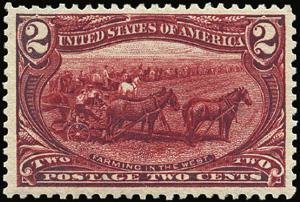Stamp: Farming in the West (United States of America 1898)
Farming in the West (United States of America 1898)
17 June (United States of America ) within release Trans-Mississippi Philatelic Exposition Issue goes into circulation Stamp Farming in the West face value 2 United States cent
| Stamp Farming in the West in catalogues | |
|---|---|
| Michel: | Mi:US 118 |
| Stamp Number: | Sn:US 286 |
| Yvert et Tellier: | Yt:US 130 |
Stamp is square format.
Also in the issue Trans-Mississippi Philatelic Exposition Issue:
- Stamp - Jacques Marquette on the Mississippi face value 1;
- Stamp - Farming in the West face value 2;
- Stamp - Buffalo (Bison bison), Hunted by Indians face value 4;
- Stamp - John Charles Fremont on the Rocky Mountains face value 5;
- Stamp - Troops Guarding Wagon Train face value 8;
- Stamp - Hardships of Emigration face value 10;
- Stamp - Western Mining Prospector face value 50;
- Stamp - Cattle (Bos primigenius taurus) in Storm face value 1;
- Stamp - Mississippi River Bridge, St. Louis face value 2;
- Se-tenant - Troops Guarding Wagon Train face value 2*8;
- Stamp - American Bison (Bos bison), Hunted by an Indian face value 4;
- Stamp - Troops Guarding Wagon Train, Horse (Equus ferus caballus) face value 8;
Stamp Farming in the West it reflects the thematic directions:
Mammals are any vertebrates within the class Mammalia (/məˈmeɪli.ə/ from Latin mamma "breast"), a clade of endothermic amniotes distinguished from reptiles (including birds) by the possession of a neocortex (a region of the brain), hair, three middle ear bones and mammary glands. All female mammals nurse their young with milk, secreted from the mammary glands. Mammals include the largest animals on the planet, the great whales. The basic body type is a terrestrial quadruped, but some mammals are adapted for life at sea, in the air, in trees, underground or on two legs. The largest group of mammals, the placentals, have a placenta, which enables the feeding of the fetus during gestation. Mammals range in size from the 30–40 mm (1.2–1.6 in) bumblebee bat to the 30-meter (98 ft) blue whale. With the exception of the five species of monotreme (egg-laying mammals), all modern mammals give birth to live young. Most mammals, including the six most species-rich orders, belong to the placental group. The largest orders are the rodents, bats and Soricomorpha (shrews and allies). The next three biggest orders, depending on the biological classification scheme used, are the Primates (apes and monkeys), the Cetartiodactyla (whales and even-toed ungulates), and the Carnivora (cats, dogs, seals, and allies).
The horse (Equus ferus caballus) is one of two extant subspecies of Equus ferus. It is an odd-toed ungulate mammal belonging to the taxonomic family Equidae. The horse has evolved over the past 45 to 55 million years from a small multi-toed creature, Eohippus, into the large, single-toed animal of today. Humans began to domesticate horses around 4000 BC, and their domestication is believed to have been widespread by 3000 BC. Horses in the subspecies caballus are domesticated, although some domesticated populations live in the wild as feral horses. These feral populations are not true wild horses, as this term is used to describe horses that have never been domesticated, such as the endangered Przewalski's horse, a separate subspecies, and the only remaining true wild horse. There is an extensive, specialized vocabulary used to describe equine-related concepts, covering everything from anatomy to life stages, size, colors, markings, breeds, locomotion, and behavior.
Agriculture is the cultivation and breeding of animals, plants and fungi for food, fiber, biofuel, medicinal plants and other products used to sustain and enhance human life.[1] Agriculture was the key development in the rise of sedentary human civilization, whereby farming of domesticated species created food surpluses that nurtured the development of civilization. The study of agriculture is known as agricultural science. The history of agriculture dates back thousands of years, and its development has been driven and defined by greatly different climates, cultures, and technologies. Industrial agriculture based on large-scale monoculture farming has become the dominant agricultural methodology.
Animals are multicellular, eukaryotic organisms of the kingdom Animalia (also called Metazoa). All animals are motile, meaning they can move spontaneously and independently, at some point in their lives. Their body plan eventually becomes fixed as they develop, although some undergo a process of metamorphosis later on in their lives. All animals are heterotrophs: they must ingest other organisms or their products for sustenance.




